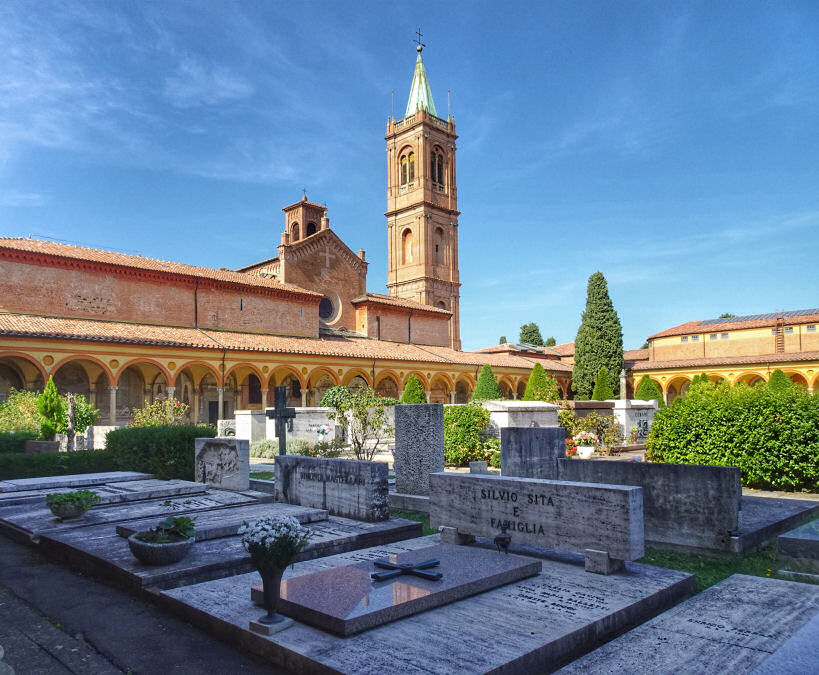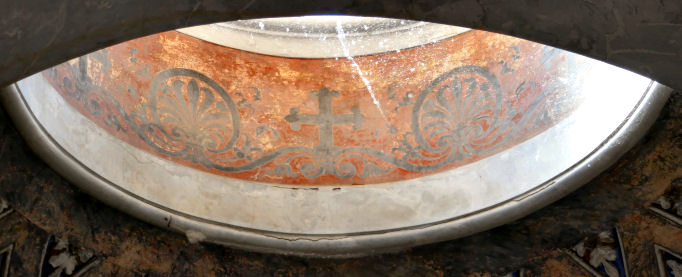|
History
The
San Girolamo della Certosa monastery cloisters and grounds became the city cemetery
from 1801, even before Napoleon's Edict of St Cloud enforced burial
outside city walls.
The first burials were in the central 16th century cloister, and monuments
from suppressed churches came here too, but work adapting and
building followed, initially in a neo-classical style. The chief architect,
from 1811
was Ercole Gasparini, Professor of Architecture at the Bologna Academy.
The Sala della Pietà with its elliptical staircase dates from the
earliest period of adaptation. Gasparini also built a long portico linking
the cemetery with the flat section of the famous portico of San Luca, joining it at the Meloncello
Arch. The first stone was laid in 1811 and in 1818 the large Guidi Arch
was built over via Sant'Isaia, but it was demolished in 1934 due to
increased traffic. The line of the portico was broken in 1926 by the Torre
di Maratona, built as an entrance to the Littoral sports complex, itself
conceived to provide the backdrop for fascist celebrations.
From 1816 to 1834 the main galleries were
built: in 1816 the Sala delle Tombe; in 1833, the Loggiato delle
Tombe and then the Sala Gemina and the Colombario with
its three naves, inspired by Roman thermal architecture. The building of
the Elliptical Hall, a small space to connect the 19th and
20th-century halls followed 1834. In 1860 the previous Chapel of the
Suffrages was turned into the Gallery of Angels followed by the
Three-Aisled Gallery connecting the structures built until then. At
the start of the 20th century the 6th cloister, with the World War I
memorial, and the 8th and 9th cloisters were built.
The local tradition of frescos, terracotta and stucco decoration held sway
during the first 15 years, but sculpture soon took over, all supervised by
the Academy with, after 1815, all designs for monuments having to be
submitted to a committee of academicians for approval.
The
discovery of an Etruscan tomb here, during work to extend the cemetery, resulted in major excavation work,
uncovering the Etruscan necropolis of Felsina in 1869, which had been in
use from the 6th to the 3rd centuries BC. This leading to the founding
of the Museo Civico Archaeologico in 1881, mostly to house the items found
here.
The spectacular galleries and decorated family tombs of the local nobility,
concentrated in the old cloister,
got the cemetery a reputation as an open-air museum from very early on, and a necessary
stop-off on Italian grand tours - Byron, Leopardi, Dickens, Sigmund Freud and
Stendhal were notable visitors who wrote about their visits.
Amongst the poets, politicians and painters buried here are the singers Farinelli and Lucio Dalla,
artists Mauro and Gaetano Gandolfi and Giorgio Morandi, the composer
Respighi and motor manufacturers Alfieri Maserati and Ferruccio
Lamborghini.
Cemetery opening times
Summer (from 1/3 to 2/11)
7.00am to 6.00pm
Winter (from 3/11 to 28/02)
8.00am to
5.00pm
The Certosa Cemetery website
The Museo Civico del
Risorgimento website
of which the cemetery is part. |
|


|